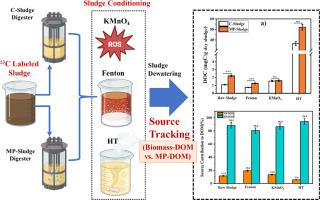利用δ¹³c标记污泥和同位素指纹法在不同条件处理下对污泥液中微塑料衍生的溶解有机物进行源特异性量化
IF 12.4
1区 环境科学与生态学
Q1 ENGINEERING, ENVIRONMENTAL
引用次数: 0
摘要
微塑料(MPs)已成为污水处理厂(WWTPs)中的持久性污染物,在污泥处理过程中积累并释放微塑料衍生的溶解有机物(MP-DOM)。本研究首次采用13c标记污泥和稳定碳同位素示踪方法对污泥液中MP-DOM进行了源特异性量化。研究人员对13c标记的活性污泥进行了有氧消化实验,并对含和不含聚乙烯MPs的活性污泥进行了处理(Fenton氧化、水热和KMnO4氧化)。MP的添加显著增加了溶解有机碳(DOC)的释放,并将DOM质量转向更不稳定的蛋白质样组分。稳定同位素分析显示,与对照相比,mp修饰的体系生物量中13C的消耗速度较慢,液相中13C的富集时间较晚,这可能表明mp对微生物碳周转有延缓作用。采用双端元同位素混合模型,发现MP-DOM在未处理污泥液中贡献了11.5%的DOC,在Fenton氧化下贡献了19.4%,在KMnO4氧化下贡献了13.5%,在水热处理下贡献了5.6%。这些结果表明,氧化处理,特别是Fenton处理,促进MP-DOM的动员,而水热处理主要促进生物质来源的DOM释放。使用光学和分子量测量的传统技术捕获了整个DOM转换,但缺乏源特异性。本研究证明了基于同位素的源分配在识别MPs对污泥液DOM的隐藏贡献方面的效用,并强调了污水处理厂处理性能、碳循环和污泥再利用策略的意义。本文章由计算机程序翻译,如有差异,请以英文原文为准。

Source-specific quantification of microplastic-derived dissolved organic matter in sludge liquor using δ¹³C-labeled sludge and isotopic fingerprinting under varying conditioning treatments
Microplastics (MPs) have emerged as persistent pollutants in wastewater treatment plants (WWTPs), accumulating in sludge and releasing microplastic-derived dissolved organic matter (MP-DOM) during sludge processing. This study presents the first source-specific quantification of MP-DOM in sludge liquor using 13C-labeled sludge and a stable carbon isotope tracing approach. Aerobic digestion experiments with 13C-labeled activated sludge, with and without polyethylene (PE) MPs, were conducted, followed by sludge conditioning treatments (Fenton oxidation, hydrothermal, and KMnO4 oxidation). MP addition significantly increased dissolved organic carbon (DOC) release and shifted DOM quality toward more labile, protein-like fractions. Stable isotope analysis showed slower 13C depletion in the biomass and delayed 13C enrichment in the liquid phase of MP-amended systems compared to control, suggesting a possible retarding effect of MPs on microbial carbon turnover. Using a two-end-member isotope mixing model, MP-DOM was found to contribute 11.5% of DOC in untreated sludge liquor, 19.4% under Fenton oxidation, 13.5% under KMnO4 oxidation, and 5.6% under hydrothermal treatment. These results suggest that oxidative treatments, particularly Fenton, promote MP-DOM mobilization, while hydrothermal treatment primarily enhances biomass-derived DOM release. Conventional techniques using optical and molecular weight measurements captured overall DOM transformation but lacked source specificity. This study demonstrates the utility of isotope-based source apportionment for identifying hidden contributions of MPs to sludge liquor DOM and underscores the implications for treatment performance, carbon cycling, and sludge reuse strategies in WWTPs.
求助全文
通过发布文献求助,成功后即可免费获取论文全文。
去求助
来源期刊

Water Research
环境科学-工程:环境
CiteScore
20.80
自引率
9.40%
发文量
1307
审稿时长
38 days
期刊介绍:
Water Research, along with its open access companion journal Water Research X, serves as a platform for publishing original research papers covering various aspects of the science and technology related to the anthropogenic water cycle, water quality, and its management worldwide. The audience targeted by the journal comprises biologists, chemical engineers, chemists, civil engineers, environmental engineers, limnologists, and microbiologists. The scope of the journal include:
•Treatment processes for water and wastewaters (municipal, agricultural, industrial, and on-site treatment), including resource recovery and residuals management;
•Urban hydrology including sewer systems, stormwater management, and green infrastructure;
•Drinking water treatment and distribution;
•Potable and non-potable water reuse;
•Sanitation, public health, and risk assessment;
•Anaerobic digestion, solid and hazardous waste management, including source characterization and the effects and control of leachates and gaseous emissions;
•Contaminants (chemical, microbial, anthropogenic particles such as nanoparticles or microplastics) and related water quality sensing, monitoring, fate, and assessment;
•Anthropogenic impacts on inland, tidal, coastal and urban waters, focusing on surface and ground waters, and point and non-point sources of pollution;
•Environmental restoration, linked to surface water, groundwater and groundwater remediation;
•Analysis of the interfaces between sediments and water, and between water and atmosphere, focusing specifically on anthropogenic impacts;
•Mathematical modelling, systems analysis, machine learning, and beneficial use of big data related to the anthropogenic water cycle;
•Socio-economic, policy, and regulations studies.
 求助内容:
求助内容: 应助结果提醒方式:
应助结果提醒方式:


